The Menu: Reserved Collection
![ht1396[2]](https://blog.itscactus.com/wp-content/uploads/2013/05/ht13962.jpg) Though we firmly feel that each and every piece of Haitian metal sculpture we carry at Beyond Borders is a wonderful piece of folk art, we have to admit a solid truth: Some pieces are wonderful, and some are remarkable. Those listed in our “Reserved Collection” section are those we consider to be the latter. Many of our sculptures are purchased as decorative pieces; that is they are works of handmade folk art that are destined to be used to embellish a space. They are fun, attractive, and have popular appeal – all well and good. Those sculptures in our “Reserved Collection” are works of higher ambition. They represent what we believe to be the finest of the art form. These are the pieces that serious collectors seek.
Though we firmly feel that each and every piece of Haitian metal sculpture we carry at Beyond Borders is a wonderful piece of folk art, we have to admit a solid truth: Some pieces are wonderful, and some are remarkable. Those listed in our “Reserved Collection” section are those we consider to be the latter. Many of our sculptures are purchased as decorative pieces; that is they are works of handmade folk art that are destined to be used to embellish a space. They are fun, attractive, and have popular appeal – all well and good. Those sculptures in our “Reserved Collection” are works of higher ambition. They represent what we believe to be the finest of the art form. These are the pieces that serious collectors seek.
So what makes them special? True folk art, according to the venerable Art Institute of Chicago, “is that which represents a unique mixture of vernacular aesthetics, personal expression, popular demand, historical fascination, memory, sentiment and patriotism.” The pieces in the “Reserved Collection” meet those criteria quite succinctly. They capture in metal sculpture the spirit of Haiti; its voodoo, its slave heritage, its island geography, its freedom, raw edges, weirdness, elegance and pride. The conveyance of these characteristics is what anchors Haitian metal folk art to value and staying power, long after the currents of decorative fashion have shifted their course.
Take for example this sculpture by Michee Ramil Remy. (HT1396) Its rough-cut execution mirrors the farmer and his rough-cut life. Scratching a living out of the soil, wresting his subsistence from the land as do nearly half of his countrymen today. The scene also harkens back to the history of Haiti as French colony, the sugar plantations being hewn under the tropical sun by the backbreaking labors of its slave population. The faces of the farmer and his daughter are enigmatic. Perhaps in them is the reflected the values of a working family and the satisfaction of a verdant, bountiful harvest, along with the sad acknowledgement that life is still very physical, and very hard. In his distinctive primitive style, Michee hammers out the essence of that existence.
You will very quickly notice, when viewing the Reserved Collection, that none of the pieces are priced. In fact, items within that category are not currently available for sale. Of course, you can always inquire as to whether the status of a particular piece could change, and perhaps you should, if you really, REALLY love it and want to know. If nobody asks the question, there isn’t anybody to say yes to….

![mask1321[1] (382x640)](https://blog.itscactus.com/wp-content/uploads/2013/05/mask13211-382x640-179x300.jpg)

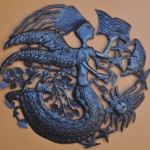


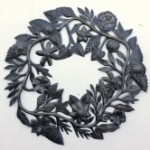




![Chihuly_at_Kew_Gardens_043[1] (640x480)](https://blog.itscactus.com/wp-content/uploads/2012/09/Chihuly_at_Kew_Gardens_0431-640x480-150x150.jpg)
![the-girl-with-a-pearl-earring-johannes-vermeer-t14769[1] (354x500)](https://blog.itscactus.com/wp-content/uploads/2012/09/the-girl-with-a-pearl-earring-johannes-vermeer-t147691-354x500-150x150.jpg) color or pattern? All of those elements play their part, to be sure. Still, my guess is that when you look at a piece of art, whether it’s a 17th century painting by Jan Vermeer, or a contemporary piece of glasswork by Dale Chihuly, or a piece of Haitian folk art by Jean Eugene Remy, it is the details that draw you in.
color or pattern? All of those elements play their part, to be sure. Still, my guess is that when you look at a piece of art, whether it’s a 17th century painting by Jan Vermeer, or a contemporary piece of glasswork by Dale Chihuly, or a piece of Haitian folk art by Jean Eugene Remy, it is the details that draw you in.![ht01387[1]](https://blog.itscactus.com/wp-content/uploads/2012/09/ht0138711.jpg) effect of the basket is achieved by cutting the contents backwards as a side piece and then bending the metal tightly behind the slitted, concave basket. A little bit more time spent in execution, but the result is good visual impact. A fine detail
effect of the basket is achieved by cutting the contents backwards as a side piece and then bending the metal tightly behind the slitted, concave basket. A little bit more time spent in execution, but the result is good visual impact. A fine detail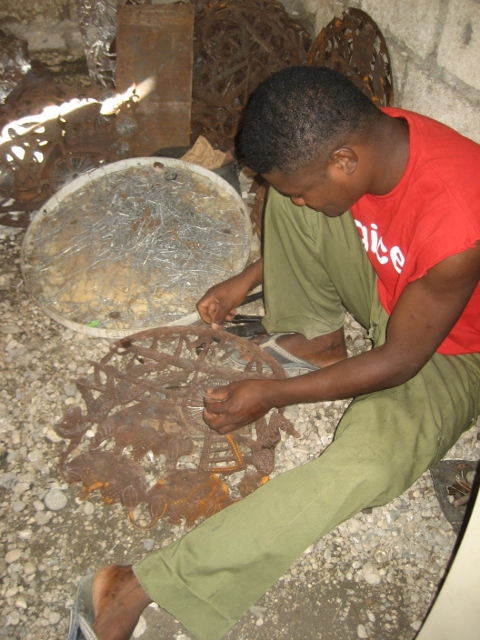 And the bus itself. Notice how small caps have been hand-riveted on the front end as headlights. Clever. The wheels, however, are the coup d’grace. They revisit vintage wire wheel hubcaps on Corvettes and Cadillacs, 1968-1982. (Yes, I looked it up, and by-the-way, you can find them on ebay for about $1250, if you’re in the market.) Jean Eugene innovatively uses spout caps and rivets and wire hooks, which are bent one at a time to create each spoke. Fifty-seven in the back and sixty-three in the front. Talk about detail!
And the bus itself. Notice how small caps have been hand-riveted on the front end as headlights. Clever. The wheels, however, are the coup d’grace. They revisit vintage wire wheel hubcaps on Corvettes and Cadillacs, 1968-1982. (Yes, I looked it up, and by-the-way, you can find them on ebay for about $1250, if you’re in the market.) Jean Eugene innovatively uses spout caps and rivets and wire hooks, which are bent one at a time to create each spoke. Fifty-seven in the back and sixty-three in the front. Talk about detail!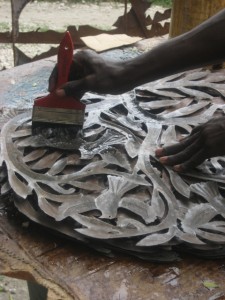 People who buy metal sculptures for the first time often ask: “Is there any care and upkeep involved with this?” Reasonable to wonder, heaven knows. We advertise that they are perfectly suitable indoors and out, but it’s obvious to anyone that’s left their bicycle out in the rain or forgotten garden tools by the sprinkler head that metal will, of course rust. Surface scratching can also occur, for instance if you are storing or stacking pieces. However, neither rust nor scratches are anything that a little clear coat application can’t correct with good result.
People who buy metal sculptures for the first time often ask: “Is there any care and upkeep involved with this?” Reasonable to wonder, heaven knows. We advertise that they are perfectly suitable indoors and out, but it’s obvious to anyone that’s left their bicycle out in the rain or forgotten garden tools by the sprinkler head that metal will, of course rust. Surface scratching can also occur, for instance if you are storing or stacking pieces. However, neither rust nor scratches are anything that a little clear coat application can’t correct with good result.
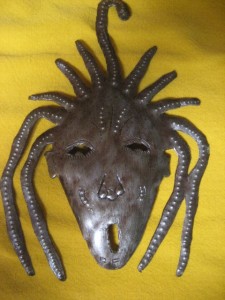 So, not that this would EVER happen to you, but if it did, do not despair. In each case, I waited until the misapplication had dried completely. Then, using first medium-coarse sandpaper and then a fine steel-wool, I removed the black/splotched/excessive coat. Finally, exercising a careful assessment of the cap color, the likelihood of imminent cloudburst, and localized bee activity, I proceed as directed on the label of the can. Quite simple, really.
So, not that this would EVER happen to you, but if it did, do not despair. In each case, I waited until the misapplication had dried completely. Then, using first medium-coarse sandpaper and then a fine steel-wool, I removed the black/splotched/excessive coat. Finally, exercising a careful assessment of the cap color, the likelihood of imminent cloudburst, and localized bee activity, I proceed as directed on the label of the can. Quite simple, really.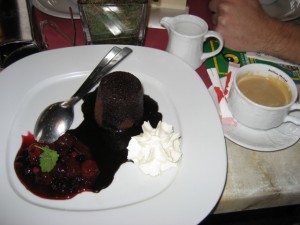 This is just my opinion, mind you, and maybe it’s really just me. But I think art acquisition ranks right up there with food and sex in terms of hedonistic drives. Anybody else? So why is that? What triggers that first impulse to buy art? And then what makes us feel compelled to buy more? When does the act of purchasing a single piece of art become a full-on libertine pursuit? And if we are so driven, how do we pursue it as gourmands, and not gluttons?
This is just my opinion, mind you, and maybe it’s really just me. But I think art acquisition ranks right up there with food and sex in terms of hedonistic drives. Anybody else? So why is that? What triggers that first impulse to buy art? And then what makes us feel compelled to buy more? When does the act of purchasing a single piece of art become a full-on libertine pursuit? And if we are so driven, how do we pursue it as gourmands, and not gluttons?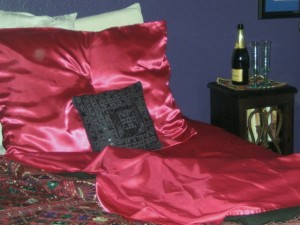
![5596[2]](https://blog.itscactus.com/wp-content/uploads/2012/08/559625-156x300.jpg)
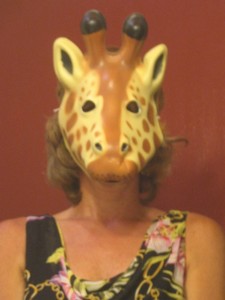
![rec381[1]](https://blog.itscactus.com/wp-content/uploads/2012/06/rec3811-85x300.jpg) How do collections get started? Maybe we’re drawn to certain images because they remind us of something special – a favorite time or place or experience. I was with my good friend, Jennifer at the San Diego Zoo one day, having an absolute ball. We were in our 40’s mind you, but I started playing with the masks at the gift shop. Holding up first the giraffe mask and then the panda mask to my face, I asked her, “Which do you like better?” To which she thoughtfully replied, “Well, the giraffe is more your color.” Immediately, I started laughing so hard I could scarcely stand up, and I bought the giraffe mask right then and there. Since then, I have bought a few other giraffe items and find myself always tempted by more.
How do collections get started? Maybe we’re drawn to certain images because they remind us of something special – a favorite time or place or experience. I was with my good friend, Jennifer at the San Diego Zoo one day, having an absolute ball. We were in our 40’s mind you, but I started playing with the masks at the gift shop. Holding up first the giraffe mask and then the panda mask to my face, I asked her, “Which do you like better?” To which she thoughtfully replied, “Well, the giraffe is more your color.” Immediately, I started laughing so hard I could scarcely stand up, and I bought the giraffe mask right then and there. Since then, I have bought a few other giraffe items and find myself always tempted by more.